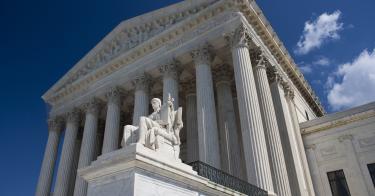In June 1788, at the New York convention considering ratification of the Constitution, Alexander Hamilton explained the system of government that it would establish this way: “Here, sir, the people govern: Here they act by their immediate representatives.”
Today, however, far too much governing is done by unelected bureaucrats in executive branch agencies. The Supreme Court’s new term began on October 2, and a case on its docket—Loper Bright Enterprises v. Raimondo—provides an opportunity to do something about it.
The Congressional Research Service explains that federal agencies make rules or issue regulations to “implement policy” that Congress establishes when it enacts statutes. It doesn’t take much to see that enforcing and implementing are different than making, but the rules and regulations keep piling up.
The Code of Federal Regulations, according to the Government Printing Office, is “an annual codification of the general and permanent rules of the executive departments and agencies of the Federal Government.” It is organized into 50 titles, or chapters, and today its nearly 250 volumes contain more than 200,000 pages.
>>> Upcoming Supreme Court Cases Could Dramatically Rein in Regulatory Agencies
Agencies increasingly cross the line from policy implementation to policymaking. Not only does this amount to government acting without clearly lawful authority, it means that each new administration will use their bureaucrats, rather than even trying to work with Congress, to make policy. Rules from one administration get rescinded, modified, or even expanded with each new arrangement of the pieces on the political chessboard.
Consider the issue in Loper Bright Enterprises v. Raimondo, a case now before the Supreme Court. Congress enacted the Fishery Conservation and Management Act in 1976. It gave authority to the National Maritime Fisheries Service to promulgate and enforce “fishery management plans,” including the requirement that “one or more observers be carried on board a vessel.”
In February 2020, the agency issued a rule requiring that New England herring fisheries not only allow these observers, but to pay their wages of more than $700 per day. Commercial herring fishermen filed suit, arguing that the statute Congress passed does not go that far.
This case is a great example of how the federal policy sausage gets made. Congress passes a general, vague, or broadly worded statute, often choosing not to use clear or concrete language to avoid political accountability. They do so figuring that the bureaucrats will fill in the blanks or even create the policy that Congress chose to avoid. The politicians take credit for popular results and blame those same faceless worker bees for the unpopular ones. Along the way, the people and their elected representatives end up governing less and less.
The Supreme Court has made this worse. In its 1984 decision in Chevron USA v. Natural Resources Defense Council, the Court said that if Congress has not “directly spoken to the precise question at issue,” courts must defer to an agency’s “permissible construction of the statute.” Congress must be direct and precise, but the agency can be merely permissible.
The agency argues that requiring fishermen to pay the observers’ wages is merely incidental to allowing them on board. Another provision of the same statute, however, shows how this doesn’t work. The statute requires fishermen to purchase certain fishing gear; complying requires them to pay money for the equipment. Complying with the mandate that observers be “carried on board a vessel,” however, requires merely, well, carrying them on board.
The U.S. Court of Appeals applied the Chevron decision and ruled for the agency. When the fisheries appealed, they asked the Supreme Court to answer two questions: whether this was a proper application of Chevron and whether the Court should either clarify Chevron or overrule it altogether.
The Supreme Court chooses which cases it will decide, and which questions in each case it will answer. On May 1, 2023, the Court agreed to take the case but to answer only the second question, that is, whether Chevron should be clarified or abandoned altogether. That makes it appear likely that the decision in this case will narrow the power of agencies to make policy—the question is how much.
Our liberty depends on Hamilton being right, that the people govern through their elected representatives. As President Andrew Jackson would say 50 years later, securing the “blessing” of liberty requires paying the price by “eternal vigilance.” Let’s hope that the Supreme Court does its part.
This piece originally appeared in Christian Renewal




